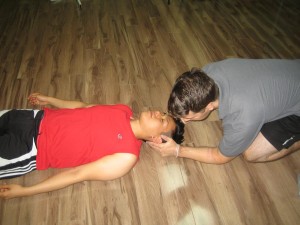It is important to note that gunshot wounds can cause significant tissue damage. There are three factors in order to determine the harshness of a gunshot wound – location, speed of the projectile and size of the projectile.
Altering the speed of the bullet makes a difference to the degree of damage done by the round. It simply means that bigger guns are capable of creating bigger holes. There are important steps to be familiar with when an individual sustained a gunshot wound.

- It is important to stay safe by practicing the universal precautions and use personal protective gear and equipment if available. Remember that any situation that involves a gun is potentially dangerous and you cannot help if your safety is at stake.
- You have to call for emergency assistance as soon as it is evident that a gun is involved. The survival rate of a gunshot wound depends critically on how speedily the individual was taken to the hospital. Ideally, an individual with a gunshot wound must be taken to the hospital in a span of 10 minutes after being shot.
- Do not attempt to move the individual unless his/her safety is in jeopardy.
- In case the individual is unconscious but breathing, you have to keep the airway open and clear from any obstruction. In case the individual is not breathing, you have to start CPR.
- If bleeding is present, you have to control it by applying pressure using a clean cloth or gauze.
- You have to seal gunshot wounds on the chest using plastic to prevent the air from being sucked into the wound. Take note that this helps prevent the development of a collapsed lung. In case the individual starts to complain of worsening shortness of breath, you have to remove the seal.
- If the individual is conscious, let him/her sit or lie down in a comfortable position. If the individual is unconscious, he/she must be placed in the recovery position.
- Avoid elevating the legs if the gunshot wound is above the waist (unless the wound is in the arm). Take note that gunshot wounds to the chest and abdomen will bleed more quickly once the legs are elevated, thus making it difficult for the individual to breathe.
- Do not provide the individual with anything to drink or eat, including water.
Useful tips when dealing with gunshot wounds
Remember that gunshot wounds are considered as puncture wounds and should be treated similarly. Do not expect to be able to differentiate between the entrance and exit gunshot wounds. There is no reliable method to distinguish them and it does not actually matter.
Take note that bullets are unpredictable and can even bounce around the inside of the individual. A gunshot wound inflicted on one side of the body that lines up with the wound on the other side of the body may or may not be connected in a straight line. Remember that there are various dynamics that affect the path a particular round can follow.
As for handguns, they can create significantly slower velocity projectiles that the rifles, thus cause less severe injuries. Just remember though that handguns are still dangerous.
